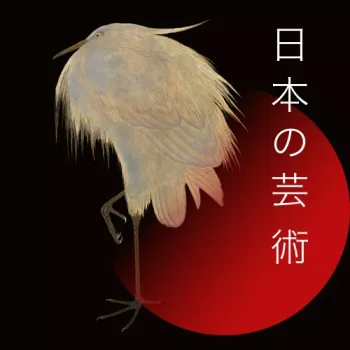Armour (dōmaru) 1537 - 1850
Iron, lacquer, shakudō, gilt copper, gold filigree, enamel, silk, brocade, leather, doe-skin, horsehair, bear fur | 147.0 x 80.0 x 55.0 cm (whole object) | RCIN 61765


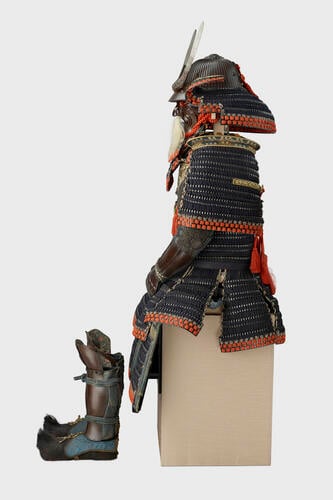
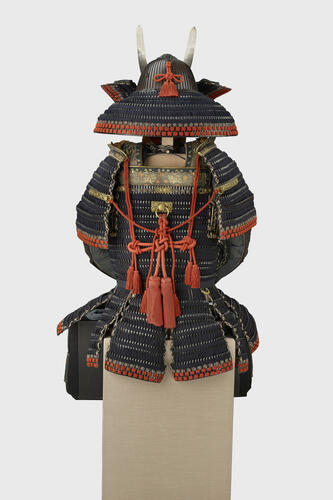

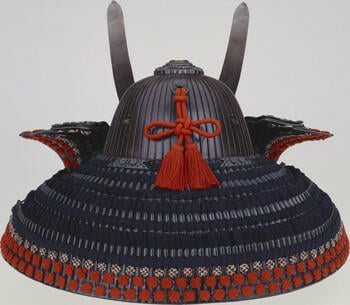
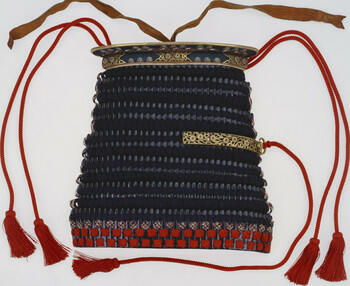

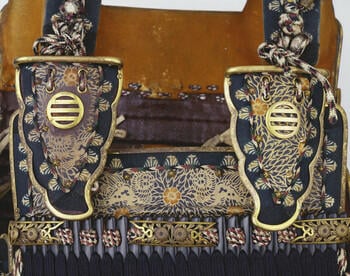
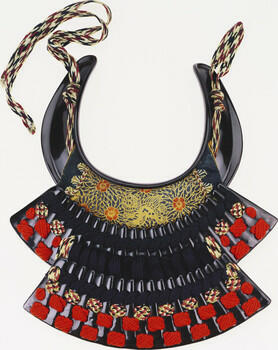
-
The Myōchin school of armourers formed part of a family line said to reach back to the twelfth century. By the Edo period, they were among the most prolific makers of armour. They also produced iron sword fittings and superb articulated iron animals such as dragons and snakes. In the early sixteenth century, Myōchin Nobuie made outstanding armour, including 62-plate helmets like the one seen here. His helmets were simple and efficient defences, and perhaps the most important part of an armour. Because they were so desirable, helmets and other armour parts carrying his ‘signature’ were frequently faked. The helmet on this armour, though remounted with later parts, such as the neck protector (shikoro), is of fine enough quality to be Nobuie’s work.
The armour comprises elements from at least two, and probably three, different armours. They were perhaps brought together and remounted specifically for presentation to Prince Alfred, Duke of Edinburgh in 1869. The helmet (kabuto) is certainly not from the same armour as the other pieces. The rims (fukurin) of the helmet are of shakudō (an alloy of copper and gold) and those of the armour are of gilt copper; all are finely carved with a pattern of scrolling grasses. The helmet bears a family crest (mon) of three horizontal bars, and this motif is also found on the protective fittings (gyōyō) on the cuirass (dō). The sleeves (kote) and shin guards (suneate) carry the signature and other details of Myōchin Munetora, who worked in the late Edo period and was perhaps son of the renowned Myōchin Muneakira (1673–1745). The half-mask (menpō) is of black lacquered iron with a horsehair moustache. Attached to the lower edge is a throat defence (yodare-kake) and beneath this is a separate throat guard (nodowa).
The armour is of the body-wrapped (dōmaru) type. The dō is constructed mainly of black lacquered leather formed in one piece to give the appearance of individual lamellae. The solid plates at the top front (muneate) and back are of iron covered in stencilled doe-skin. The armour is laced with dark blue silk and mounted on blue silk brocade. The rims (fukurin) of the armour and helmet are of shakudō or gilt and are finely carved with scrolling grasses. The mail sleeves (sode) with hammered iron plates are additionally decorated with the head of the fearsome mythical lion–dog (shishi) and iron plates pierced in the form of cherry blossom. The boots are of leather and brocade silk covered in black bear fur.
Text adapted from Japan: Courts and Culture (2020)Provenance
Presented to Prince Alfred, Duke of Edinburgh by the Emperor Meiji on 22 September 1869.
Loaned to the Fine Art Society Exhibition of Japanese Art at New Bond Street, London, 1888 (cat. p. 77).
Loaned to the exhibition 'Arms and Armour of Old Japan' by the Japan Society, Pall Mall East, 1905 (cat. no.4). Sent from Windsor Castle for exhibition at The British Exhibition at White City, London, in 1910. Exhibited at the Exhibition of Japanese Armour, Tower of London, 1965. -
Creator(s)
(nationality)Acquirer(s)
-
Medium and techniques
Iron, lacquer, shakudō, gilt copper, gold filigree, enamel, silk, brocade, leather, doe-skin, horsehair, bear fur
black silk, red silk, black enamel, shakudo, gold?, gilt, enamel, bronze, bear fur, copper alloy, iron, leather, skin, furMeasurements
147.0 x 80.0 x 55.0 cm (whole object)
3180 g (Weight) (whole object)
568 g (Weight) (whole object)
468 g (Weight) (whole object)
770 g (Weight) (whole object)
766 g (Weight) (whole object)
970 g (Weight) (whole object)
972 g (Weight) (whole object)
5190 g (Weight) (whole object)
74 g (Weight) (whole object)
80 g (Weight) (whole object)
1180 g (Weight) (whole object)
738 g (Weight) (whole object)
728 g (Weight) (whole object)
218 g (Weight) (whole object)
216 g (Weight) (whole object)
Category
Object type(s)
Place of Production
Japan




